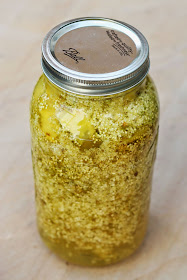[I repost this recipe annually.]
I love elderflower cordial. I used to settle for commercial versions (some very good). But in June 2014 I walked into a grove of elderbushes in bloom and struck white umbel nirvana. I picked till I was drunk. Then I began to read.
The manymany cordial recipes I researched were very similar, though some use even more sugar, and about half called for citric acid.
Having made several batches over three summers, I know now that fermentation speeds vary. My recipe below calls for 4 days, but I have made a batch that I bottled only after 8 days, because it started out so slowly (I picked the flowers after rain, which I think affected the yeast) and then remained very active. Please do more reading on your own.
I recommend Sandor Katz's The Art of Fermentation (Chelsea Green, 2012). Pay special attention to Page 91.
Wild yeast fermentation is not - in my experience - a precise science. These bugs are alive, and they behave according to the wiles of weather and sugar and temperature and plant. I do realize that the more sugar I use the more volatile the fizz - yeast feeds on sugar and burps carbon dioxide, which causes carbonation. By all means, experiment with less sugar. Some botanicals are more active than others. Flowers are fastest, they seem to hold the most yeast.
Elderflower Cordial - a fizz
(I use the same method for common milkweed flowers, but with half the lemon juice)
6 oz / or approx. 30 elderflower umbels
1 lb sugar/450 grams sugar
1.5 liters /52 fluid oz/6 cups water
1/2 cup (about 3-4 lemons-worth) fresh lemon juice
Zest of 4 lemons, peeled in strips, without pith
Don't wash the flowers. Instead, shake them upside down over a cloth to evict any small insects. Strip the tiny white flowers from the green stems, using your fingers. Discard as much green as possible (in any plant it will add a tannic note, but with elderflowers the green is toxic). Weigh the flowers, if weighing, and pack them lightly into a large mason jar (I use a 1.5 liter capacity jar). Dump the sugar on top of them.
Add the cool water, the lemon juice and the zest, stir well, and screw the lid on loosely. In a wire top jar either burp daily or secure double layers of muslin over the top of the open jar with a rubber band. At this stage the ferment actually needs air.
Leave the jar at room temperature for 4-ish days. Stirring helps, but you don't have to, as elderflowers seem particularly active.
Whatever you do, don't walk away from a sealed jar and forget about it for days or you could have an elderflower detonation on your hands...
After Day 4 (-ish), or when you notice the elderflowers rising and pushing up out of the jar (that's carbonation happening) strain through a fine mesh strainer and then again through cheesecloth. Bottle, and keep in the fridge for peace of mind. You can keep it in a cool cupboard, but you should check it and burp it (open the lid slowly) daily to allow accumulated gas to escape.
Plastic bottles safer if you are nervous about possible explosions - the plastic bulges out when over-carbonated, giving you a very good clue that it wants to blow. Open over a sink, or outside.
To drink, dilute with sparkling water, add to a gin and tonic, or to shaken cocktails (like this one, with vermouth, or this one, with hyssop, or this one, with mint and gin), or simply splash into a glass of prosecco or Champagne.
Good luck not finishing this in a week, flat.




HI Marie. This is my second year making cordial from your recipe. I started the brew three days ago, and found mold on top of the flower "float" today. I scooped it off and stirred the mixture. I hadn't stirred since starting, so that's probably the reason for the mold. Do you think it will be okay to continue fermenting? If it tastes off I'll pitch it, obviously. BTW, of the two tiny batches I made last spring, one was super delicious/not fizzy, the other was Champagne-fizzy but sour.
ReplyDeleteHi Lisa - so sorry I missed your comment. Mold can form if there is no stirring, so what you did sounds fine. Fizzy but sour sound like the yeasts had eaten all the sugar and new yeasts (acetobacter) had begun to make acetic acid...
Delete